Meet The First Known Neanderthal Family Discovered in Siberian Cave
Scientists discovered evidence of our closest prehistoric relatives.

Researchers have discovered evidence of the very first Neanderthal family inside a cave in Siberia. It’s the largest group of Neanderthal genes ever found in one site, and researchers say the findings will provide a better idea of how Neanderthals lived and humans developed. The discovery was made in Chagyrskaya Cave, located in northern Siberia. There, scientists found the remains of a father, his teenage daughter, two other relatives, and seven other individuals.
“Personally, I don’t think there is particularly good evidence that Neanderthals were much different from early modern humans that lived at the same time,” Benjamin Peter, a senior author of the study, told Nature. “We find that the community we study was likely very small … Nevertheless, they managed to persevere in a rough environment for hundreds of thousands of years, which I think deserves great respect.”

The Neanderthals are believed to be the closest prehistoric relatives to humans. They lived primarily in Eurasia, from about 430,000 years ago until they became extinct 40,000 years ago. They were heavy-browed, large-brained, and shorter than modern humans. Genetic research indicates that Neanderthals interbred with homo sapiens—the modern human species—about 55,000 years ago when they met in Africa.
Many people whose families originated in Europe and Asia have a small percentage of Neanderthal DNA today. It’s also believed that Neanderthals displayed some of the same behavior as homo sapiens. This includes burying their dead, using tools, and creating pictures and symbols on the walls of caves. That makes scientists particularly eager to learn more about their social structures, including family life.

In 2020, researchers looked at DNA from a female Neanderthal found in Chagyrskaya Cave. It seemed to be different from DNA of other remains found nearby. So German scientists extracted DNA from 17 other sets of remains in Chagyrskaya and a nearby cave. The scientists were able to analyze DNA from eleven individuals.
They were surprised to find that two of them—an adult male and a teenage female—shared half of their DNA, which meant they were siblings or a parent and child. Their mDNA—which is transmitted from mother to child—was found to be different, suggesting they were father and daughter.

The researchers also found the pair shared other DNA characteristics with other individuals found at the site, including a male and female who were second-degree relatives, potentially cousins.
“It makes you wonder what the familial relationship between these individuals were and how they were interacting with each other,” said paleogeneticist Laurits Skov, who led the research team. “It is a little glimpse into a Neanderthal family.”

The unusually rich trove of genetic data allowed the scientists to make other suppositions about how Neanderthals lived. The DNA of the Chagyrskaya Neanderthals all had low diversity between maternal and paternal copies, suggesting the number of breeding adults was low. The scientists also found that maternally inherited genes were much more diverse than the Y chromosomes passed down along the male line, suggesting female Neanderthals were more mobile.
The researchers have analyzed less than a quarter of the Neanderthal remains discovered at the site, and they hope to discover more relatives to fill in the family tree. Skov believes that may include the teenage girl’s mother. “She’s probably also in there,” he said.

Dr. Lara Cassidy, an assistant professor in genetics at Trinity College Dublin, told the Guardian the study was a “milestone.” “Understanding how their societies were organized is important for so many reasons,” she said.
“Down the line, if we have more studies like this, it may also reveal unique aspects of the social organization of our own homo sapiens ancestors. This is crucial to understanding why we are here today and Neanderthals are not.”














